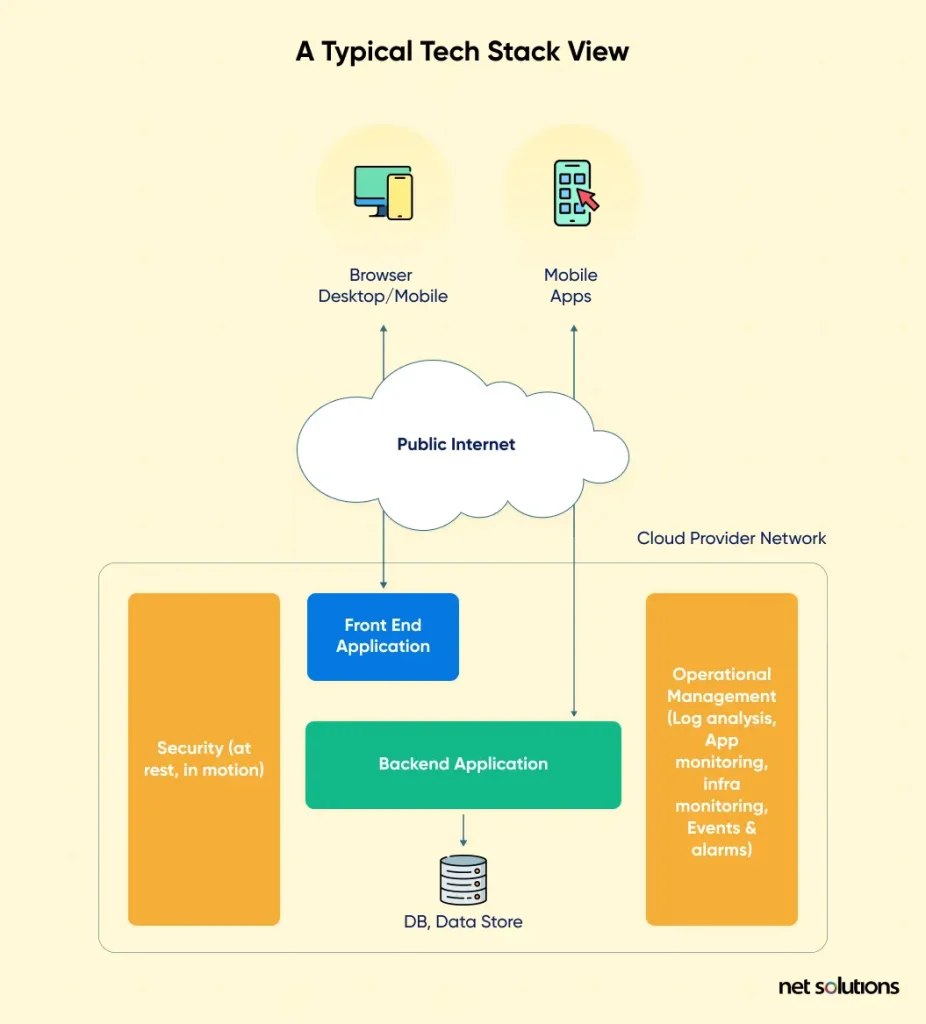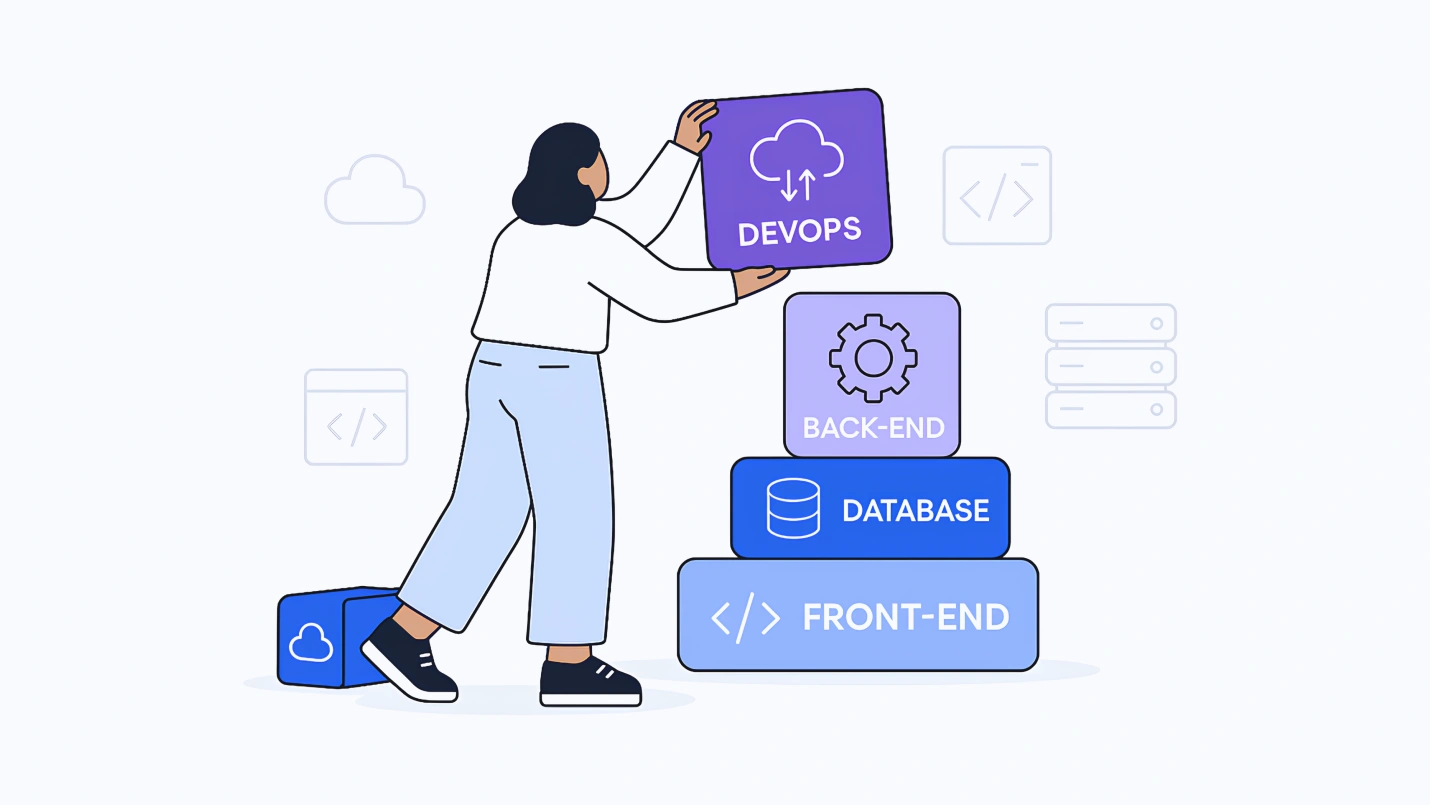In today’s digital world, companies leverage technology to stay ahead of the competition. A well-optimized technology stack for a product not only enhances productivity, efficiency, and security, but also enables them to offer innovative solutions that align with ever-evolving market demands.
Technology Stack Ecosystem:
Before diving into specific recommendations, it’s crucial to understand what a tech stack is. A tech stack, short for technology stack, refers to a combination of software tools, programming languages, frameworks, and infrastructures used to build and run a web or mobile application.
Let’s break down the key components of a product’s tech stack:
1. Front-End: The front-end, or client-side, is what users interact with directly. It includes the User Interface (UI) and User Experience (UX) components of your application. Choosing the right front-end technologies can greatly influence how users perceive and interact with your product.
2. Back-End: The back-end, or server-side, handles the logic, data processing, and communication with the data store. A solid back-end technology ensures your application is robust, scalable, and secure.
Depending on the requirements, the back-end can be developed in a single language or multiple languages. Also, the requirements will drive the decision to develop the application as a monolithic or in a microservices model (breaking the application into modular, manageable services).
3. Databases and Data Storage: Databases store and manage the data your application relies on. The choice of a database system impacts data integrity, retrieval speed, and scalability.
4. Cloud Infrastructure: Cloud services are the backbone for hosting, scaling, and securing your applications. Selecting a reliable cloud provider enables the application to handle growing numbers of concurrent users as well as handle peak loads during periods of high usage.
5. DevOps and Deployment: DevOps practices and tools facilitate Continuous Integration/Continuous Delivery (CI/CD) and automation.
A well-implemented DevOps pipeline ensures smoother deployments and efficient development workflows. Today customers expect an application to operate 24/7 without any downtime. A strategically chosen DevOps process enables the release of new versions of applications without any downtime.
Here is a simplified view of a tech stack.

Choosing the right tech stack will depend on your specific industry since different sectors have different demands. That’s why we’ve compiled advice for IT professionals who are rethinking their tech stacks in the following five industries:
- Retail and eCommerce
- Healthcare
- Finance
- Education
- Media, Publishing, and Entertainment
- Sports and Fitness
Read on to learn how to compile a tech stack ideally suited to your industry.
Why Is Having the Right Technology Stack So Important?
Choosing the right tech stack is key to any business’s success, and uniquely tailoring your tech stack to your business model and industry is essential.
A retail company, for example, will require a tech stack that supports supply chain management technology and solid ERP and CRM integrations (among other things). Meanwhile, a media company will need a tech stack that supports video streaming, community engagement, and other specialized technology unique to the field.
Different tech stacks have their own advantages and drawbacks, and choosing applications and infrastructure that don’t support your company’s goals can result in:
- Higher operational costs due to workarounds and other issues
- Delayed timelines for deliverables
- Compromised security due to inadequate software
- High turnover among tech teams frustrated by working with an inadequate tech stack
All this underscores the importance of choosing the right tech stack from the start. The next best option is switching to a tech stack better suited to your business once you understand the challenges you face with an existing, inadequate tech stack.
6 Factors to Consider When Selecting a Technology Stack
As with any pivotal business decision, choosing the right tech stack means carefully weighing business needs and priorities with budgets and resources.
Your cost-benefit analysis should consider both your current needs and your long-term goals, supporting key requirements as your company grows. Consider the following six factors when building your tech stack to support your plans and future-proof your business.
1. Objective function of the business
A digital application is a means to achieve the objective function of the business. It is possible the objective function of the business evolves over the period of the lifecycle starting with finding a product-market fit to scaling and serving billions of users across different geographies. The expectation of the business should drive the choice of tech stack.
When identifying business requirements, explore your:
- Overall business goals
- The demographic you serve
- Customer experience goals
- User expectations
- Governance of the application
- Specific compliances (e.g., GDPR, HIPAA) for the industry and state, country, or region you serve
Consider how various technologies feed into your larger goals. Solicit feedback from customers, internal users, and your IT team to better understand and flesh out these key requirements.
2. Industry and niche-specific needs
We’ll explore industry-specific tech stack recommendations below, but here are some general tech requirements for each of the sectors we highlight in this guide.
Retail and eCommerce
Retail companies with an online presence need to create a flawless online experience. If they have a brick-and-mortar store, they need to connect the store to their online platform to share inventory data and track. Additionally, strong data collection and analysis is a must for any eCommerce business to compete in a tight market.
They also require quality CRM and ERP integrations, and supply chain management software. Physical stores may benefit from proximity marketing that uses GPS, NFC, BLE beacons, and QR codes.
Healthcare
Hospitals, doctors, and other healthcare providers need a tech stack that supports an impressive User Experience (UX) and User Interface (UI) to handle patient portals.
They also benefit from state-of-the-art data management and security to keep health records secure, and they need systems that support their efforts to maintain compliance. Lastly, modern healthcare requires video streaming technology for telemedicine, along with strong analytics capabilities to understand patient trends.
Finance
Banks and financial institutions need strong security and compliance technology. Their customers benefit from intuitive UI and UX that work with desktop and mobile apps. They also need to handle seamless transactions, including those from digital wallets and other peer-to-peer money transfer systems.
Lastly, high availability is key for the financial industry since customers need to access bank accounts and other financial records around the clock. A well-defined cloud/on-premise infrastructure is critical to keep things running and minimize downtime. Cloud infrastructures like AWS and Microsoft Azure are known for their reliability.
Education
Universities, schools, and companies that handle training and education need a tech stack that supports the latest developments in EdTech, including eLearning platforms that can handle student submissions, instructor feedback, and parental reviews (for K-12 learning).
Video and streaming that supports virtual learning is a must, and mobile applications that allow students to access educational content on the go are a great value add.
Media, Publishing, and Entertainment
Tech stacks that support video streaming are essential, along with monetization solutions that include advertising and (potentially) eCommerce.
Digital publishing, publishing workflow management, mobile solutions, Augmented Reality (AR), Virtual Reality (VR), and Over the Top (OTT) media solutions may all be of interest to media, publishing, and entertainment companies.
Sports and Fitness
Sports and fitness companies often create apps that make good use of gamification and AR, interfacing with wearables and allowing users to track fitness goals.
Many make use of eCommerce or advertising for monetization, and they often benefit from multimedia streaming and distribution. Community building is also key for fitness apps, and that requires a tech stat that supports data analytics to analyze the mountains of customer data their apps produce—otherwise, it’s a missed opportunity.
3. Cost
Costs can vary greatly when building or upgrading a tech stack. Open-source technology can save money, but it might cost you more in the end if it has a steep learning curve or doesn’t deliver the functionality you require. Mind you, there is plenty of excellent open-source technology out there, you just need to carefully vet every piece of software you use.
Choosing the right tech stack to fit your budget means weighing upfront costs with long-term requirements, and there will always be trade-offs. With this in mind, conduct a thorough cost-benefit analysis and choose the most future-proof technology you can find without breaking the bank.
4. Security and Compliance
Cyber security is a must for any organization, and it’s especially important for industries like finance and healthcare—where compliance comes into play as well.
We all remember the Equifax security breach of 2017, which resulted in a $425 million settlement and hearings before the U.S. House of Congress. That sort of breach is catastrophic, and using a modern tech stack with proper security can help you reduce risk.
Modern, cloud-based apps tend to be far more secure than legacy systems with outdated software, especially if security updates are no longer available for an older application.
Compliance is also an important factor, and regulations like GDPR (for general customer data in Europe) and HIPAA (for healthcare data in the U.S.) are powerful and wide-reaching.
Of course, while GDPR and HIPAA are some of the most well-known regulations, there are many more that apply to different geographies and different industries. A few additional, broad-reaching regulations include:
- California Consumer Privacy Act (CCPA): Regulates the use of data for California residents.
- Gramm-Leach-Bliley Act (GLBA): Outlines strict requirements for data-handling in the financial sector.
- Payment Card Industry Data Security Standard (PCI DSS): Relates to credit card handling for online retailers who sell to U.S. customers.
Needless to say, there are many, many more regulations that may apply to your sector and your region. Make sure you’ve addressed them all, and that your tech stack can support your efforts to remain secure and compliance.
5. Integrations
Today’s software systems are deeply interconnected, and strategic integrations can help you get the most out of your tech stack. However, a poorly integrated tech stack can result in:
- Extensive rework
- Productivity loss
- Client frustration and a loss of business
Pay careful attention to the various systems you use to ensure they integrate well and work together as seamlessly as possible.
6. Scalability
Scalability is one of the most important benefits of app modernization, and a cutting-edge cloud-based architecture allows for flexibility and growth. Companies with tech stacks that enable scalability won’t have to worry that they’re expanding too quickly or experiencing spikes in use or traffic.
Modern systems achieve scalability in a variety of ways. First, cloud computing itself allows for scalability thanks to the pay-as-you-go model of data use. Second, all the elements of modern apps (e.g., microservices, API-first, headless architecture) allow for tremendous flexibility.
Industry-Specific Technology Stack Recommendations
Over the past 30+ years, we’ve worked with countless companies here at Net Solutions to tailor their tech stacks to their ever-changing industries.
Based on our experience, we’ve compiled a list of software recommendations for each of the industries we mentioned above, but keep in mind that this is just a starting point. Your specific needs will depend on your business model and the functionality you’re hoping to achieve.
We’ve linked to relevant case studies that describe our work in each industry, that way you can discover how we tailored different tech stacks to meet each client’s needs and learn from their experience.
Retail & eCommerce
The retail sector has seen a vast transformation since the COVID-19 pandemic. With legacy retail brands embracing cutting-edge tech through eCommerce, supply-chain optimization, and other elements of digital transformation, there’s simply no going back.
Recap of industry-specific needs that the tech stack should support:
- Seamless in-store and online shopping experience
- Comprehensive CRM and ERP integrations
- Modern, cloud-based supply chain management capabilities
- Proximity marketing via GPS, NFC, BLE beacons, and QR codes
- Composable architecture for versatility and future-proofing the business
A genuinely composable architecture is comprised of cloud-native, component-based, and tech-agnostic systems. MACH architecture (Microservices-based, API-first, Cloud-native, Headless) is the technical foundation that makes composable commerce possible. It’s the very thing that allows you to easily swap out one feature for another, or add new features at will.
Tech Stack Recommendations
- Front-End: ReactJS, AngularJS, Vue.js, Native Android & iOS
- Back-End: BigCommerce, Magento 2, Adobe Commerce, Shopify, OR Custom Development (PHP, Python, etc.).
- Database: PostgreSQL, MySQL
- Cloud Services: AWS, Azure, and GCP
- Payment Integration: Stripe, PayPal, Square, Braintree, Authorize.net, etc.
- Analytics: Google Analytics, HotJar, VWO, Amplitude, Mixpanel, Pendo for user behavior. PowerBI, Tableau for report Visualization or have a custom-built reporting engine in place.
Retail and eCommerce Case Studies
- Euro Car Parts: Multi-channel eCommerce Solution for One of IRUK’S Top 500 Retailers
- 2XU: Delivering the Technical Expertise to Drive the Global Expansion of an Australian Sports Apparel Retailer
- FMCG: Perfecting an App that Empowers Women Entrepreneurs in Rural India to Build Thriving Local Businesses
Healthcare
Healthcare is an immensely complex industry that relies on cutting-edge technology to protect privacy, control costs, and save lives.
Recap of industry-specific needs that the tech stack should support:
- Patient portals
- Mobile healthcare apps
- Medical practice management and operations software
- Telemedicine technology, including streaming capabilities
- Healthcare analytics
- Compliance and security systems
Tech Stack Recommendations
- Front-End: ReactJS, AngularJS, Vue.js, HTML/Bootstrap, Native Android/ iOS, Cross Platform (mobile apps)
- Back-End: Python, PHP, .Net
- Database: PostgreSQL, MySQL, MS SQL
- Cloud Services: AWS, Azure, and GCP
- Security Compliances: HIPAA (Health Insurance Portability and Accountability Act), HITECH (Health Information Technology for Economic and Clinical Health Act), PIPEDA, and others depending on the location
- Telemedicine Video Conferencing: Zoom Healthcare, Doximity, MS Team, Twillio, SendBird
- Electronic Health Records (EHR): MEDITECH Magic, eClinicalWorks, NextGen Healthcare
Healthcare and Health-related Case Studies
- EMR: Building a Bespoke Decision Support Engine to Enable Healthcare Staff to Manage Test Results
- OCR: Building a Mobile Social Platform for Healthcare Professionals
- Drive Focus: Building a Video Streaming Simulator for Drivers with Cognitive Disabilities
Education & Training
Education and training is a multi-billion dollar industry that ranges from universities to corporate training, and it also includes companies working to support online learning through innovative technology.
Recap of industry-specific needs that the tech stack should support:
- Learning Management Systems (LMSs)
- Virtual classroom solutions
- Mobile learning applications
- Remote learning solutions
Tech Stack Recommendations
- Front-End: ReactJS, AngularJS, Vue.js, HTML/Bootstrap, Native Android/iOS, Cross Platform (mobile apps)
- Back-End: Python, PHP, .Net
- Database: PostgreSQL, MySQL, MS SQL
- Learning Management System (LMS): Moodle, Articulate, Chamilo, Rustici (SCORM), LearnDash
- Video Conferencing: Twilio, Zoom, Google Meet, BigBlueButton
- Analytics: Moodle Analytics, Articulate Analytics, Google Analytics, HotJar, VWO, Amplitude, Mixpanel, Pendo for user behavior. PowerBI, Tableau for report Visualization or have a custom-built reporting engine in place.
Education and Training Case Studies
- Harvard Business Review: Building HBR Ascend—a Digital Learning Platform
- Edplace: Empowering a London-based EdTech Startup to Scale
- Avance: Designing and Building a Spanish-language Corporate Training App
- Podeum: An online resource curation platform
Finance
Banking and financial services require accuracy, top-notch security, and strict compliance. Anything short of a tech stack that delivers this key functionality could result in business failure or even criminal negligence.
Recap of industry-specific needs that the tech stack should support:
- Digital Wallets
- Custom Web & Mobile Apps
- Lending solutions
- UX services for better digital banking
- Security and compliance
Tech Stack Recommendations
- Front-End: ReactJS, AngularJS, Vue.js, HTML/Bootstrap, Native Android/ iOS, Cross Platform (mobile apps)
- Back-End: Python, PHP, .Net
- Database: PostgreSQL, MySQL, MS SQL
- Security: AWS Identity and Access Management (IAM), Azure Active Directory (AAD), Google Cloud Identity and Access Management (IAM)
- Fintech APIs: Fintech APIs are heavily dependent on the banking system or platform used for backend solutions, so it doesn’t make sense to mention specific solutions.
- Compliance: Compliance requirements vary greatly depending on the region served and each institution’s requirements.
Financial services case study
- Kitco: Building a Precious Metal Trading Company’s Android App
- Afrexim: Modernizing an International Bank’s Mission-critical Internal Platform
Media, Publishing, and Entertainment
Media, publishing, and entertainment are constantly reinventing themselves, with new technologies arising to support cutting-edge video protocols, new streaming technology, and even Augmented Reality (AR) and Virtual Reality (VR).
Recap of industry-specific needs that the tech stack should support:
- Powerful streaming capabilities
- Advertising and monetization software
- Modern eCommerce solutions (for many media companies)
- Mobile solutions
- Augmented Reality (AR) and Virtual Reality (VR)
- Over The Top (OTT) media solutions
Tech Stack Recommendations
- Front-End: ReactJS, AngularJS, Vue.js, HTML/Bootstrap, Native Android/ iOS, Cross Platform (mobile apps)
- Back-End: Python, PHP, .Net
- Database: PostgreSQL, MySQL, MS SQL
- CMS: Contentful, WordPress, Drupal, Adobe Experience Manager, Google Cloud Content Management
- Content Delivery: Amazon CloudFront, Azure Content Delivery Network (CDN), Google Cloud CDN, Cloudflare
- Streaming: Wowza Media Streaming Engine, Vimeo, Dacast, Castr Streaming Engine
- User Engagement: Pendo, Hotjar, Amplitude, Mixpanel
- Analytics: Google Analytics, HotJar, VWO, Amplitude, Mixpanel, Pendo
Media, Publishing, and Entertainment Case Studies
- English Premier League: Building an iPad App for IMG that Streams English Premier League Events and Updates Content
- Soaq: An Enterprise Video Platform that Maximizes Employee Engagement
- Captiv8: Handling End-to-End Design for a Platform that Connects Brands with Influencers
Sports & Fitness
Sports and fitness has gone fully digital in the past 15 years, from wearable devices to calorie and workout trackers. This brings large volumes of customer data that have helped sports retailers learn about health trends and plan their marketing and product development around it.
Recap of industry-specific needs that the tech stack should support:
- Gamification within an app
- Integration with wearables
- Monetization through eCommerce and/or advertising
- Multi-media distribution
- Strong data analytics to process large amounts of customer data
Tech Stack Recommendations
- Front-End: ReactJS, AngularJS, Vue.js, HTML/Bootstrap, Native Android/ iOS, Cross Platform (mobile apps)
- Back-End: Python, PHP, .Net
- Database: PostgreSQL, MySQL, MS SQL
- Wearable Integration: Apple HealthKit, Google Fit, Fitbit API, Garmin Connect IQ
- Real-time Data: Amazon Kinesis, Azure Event Hubs, Socket.io, Pusher, Ably
- Virtual Coaching: Agora.io, Twilio Video, Amazon Chime SDK, Google Cloud Video Intelligence API, Strava API, TrainingPeaks API
- Gamification: ClassDojo, Fishbowl, Fun Run
Sports & Fitness Case Studies
Make Informed Decisions with Net Solutions
Choosing the right tech stack requires an intimate understanding of your industry and your unique business model, along with comprehensive knowledge of the current technological landscape.
Net Solutions has worked with businesses across many industries, from startups to international enterprises. We’re a full-service software development firm, and we can help you plan your tech stack from scratch—or modernize your existing technology to make you more productive and competitive.



